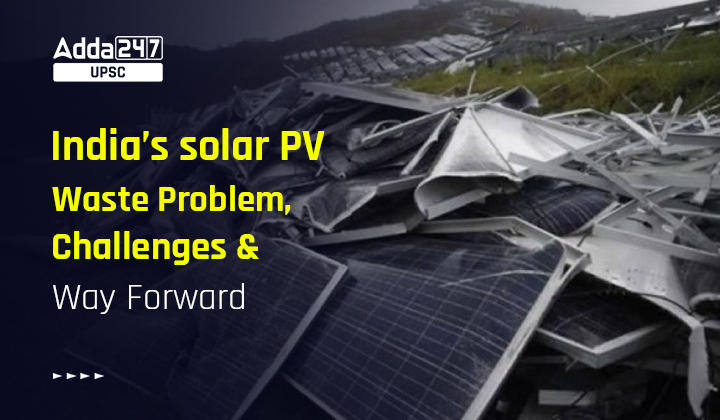Table of Contents
India’s solar PV Waste Problem: These are the discarded or unusable solar panels and components, which are generated when solar panels reach the end of their useful lives or become damaged. India’s solar PV Waste Problem is also important for UPSC Prelims Exam 2023 and UPSC Mains exam (GS Paper 3- Pollution and various policies and programs to end pollution in India and the world).
What Is Skyglow Light Pollution?
India’s solar PV Waste Problem in News
In recent years, policymakers in India have made a significant effort to move towards a circular economy and to facilitate efficient waste management. However, there is still a lack of clear guidelines for managing waste in the solar photovoltaic (PV) industry.
Solar PV Wastes in India
India has the fourth highest deployment of solar photovoltaic (PV) systems globally, with an installed capacity of almost 62GW as of November 2022. However, this also means that there is a huge amount of potential solar PV waste in the future.
- According to a report by the International Renewable Energy Agency in 2016, India could generate anywhere between 50,000 to 325,000 tonnes of PV waste by 2030, and this number could rise to over four million tonnes by 2050.
- With the rapid installation of photovoltaic panels across the country, India is projected to produce a vast amount of waste over the next two decades, potentially making it one of the world’s top five photovoltaic waste producers by 2050.
World Bank’s Report on Air Pollution in South Asia 2022: Where India Stands?
Solar Photovoltaic (PV) Technology in India
The predominant technology used for solar PV installations in India is crystalline silicon (c-Si). A typical PV panel in India is composed of 93% c-Si modules and 7% cadmium telluride thin-film modules.
- A c-Si module is comprised of several components, including a glass sheet, an aluminium frame, an encapsulant, a backsheet, copper wires, and silicon wafers.
- The c-Si module is manufactured using silver, tin, and lead. The thin-film module, on the other hand, is made of compound semiconductors, glass, and encapsulant.
How Solar PV Waste is Generated?
As solar panels approach the end of their lifespan, certain components of their frames are extracted and sold as scrap, while junctions and cables are recycled in accordance with e-waste guidelines.
- The glass laminate is partially recycled, and the remainder is typically disposed of as general waste.
- Silicon and silver can be retrieved by incinerating the module in cement furnaces, which has been found to recover approximately 50% of the total materials.
Hazards Associated with Solar PV Waste
India faces a challenge with the increasing amount of informal handling of PV waste, with only about 20% of the waste being formally recovered.
- The informal handling of waste leads to accumulation in landfills and pollutes the surrounding environment.
- Furthermore, incinerating the encapsulant releases sulphur dioxide, hydrogen fluoride, and hydrogen cyanide into the atmosphere.
- India faces substantial obstacles in collecting, storing, recycling, and repurposing PV waste.
- The market for repurposing or reusing recycled PV waste in India is negligible, primarily due to a lack of adequate incentives and schemes that businesses can invest in.
Way Forward
There are three critical steps India should take to improve PV waste management.
- Firstly, it should avoid the confusion that may arise from grouping PV waste with other e-waste and instead create specific provisions for PV waste treatment within the e-waste guidelines.
- Additionally, a Central insurance or regulatory body should be established to protect against financial losses incurred in the collection and treatment of waste.
- Secondly, to emphasize the hazardous nature of PV waste, sensitization and awareness programs on PV waste management should be conducted nationwide.
- Finally, since India has limited domestic solar PV-panel manufacturing, there is a need for more attention on local R&D efforts.
- Depending solely on one type of module would lead to uneven depletion of specific natural resources and hinder the local capacity for recycling and recovering crucial materials.
- Thus, the development of PV waste recycling technologies domestically should be promoted through appropriate infrastructure facilities and adequate funding.
Conclusion
It is crucial for India to implement unambiguous policy directives, effective recycling strategies, and increased collaboration at present, to avoid being caught off guard by a future challenge.
Biotransformation Technology, Transforming Plastic Waste into Biodegradable Waste
Biotransformation Technology, Transforming Plastic Waste into Biodegradable Waste



 TSPSC Group 1 Question Paper 2024, Downl...
TSPSC Group 1 Question Paper 2024, Downl...
 TSPSC Group 1 Answer key 2024 Out, Downl...
TSPSC Group 1 Answer key 2024 Out, Downl...
 UPSC Prelims 2024 Question Paper, Downlo...
UPSC Prelims 2024 Question Paper, Downlo...
